The Impact of Green Infrastructure on Mitigating Urban Heat Island Effect: Current Status, Trends, and Challenges
Abstract
1. Introduction
- Systematic Literature Review and Knowledge Mapping: This paper provides a comprehensive analysis of the global research landscape on GI aimed at mitigating UHI effects. It examines various dimensions, including annual publication trends, geographical distribution, output by countries, institutions, and authors, as well as co-citation networks and keyword co-occurrence analysis. The objective is to offer scholars a systematic literature review, intuitive visual knowledge maps, and insights into the evolution of research trends.
- In-Depth Analysis of Research Hotspots: This study focuses on identifying key research hotspots from the perspectives of technological mechanisms and social governance. It elucidates the core issues in current research, the challenges encountered, and the evolving directions of technological approaches. The aim is to offer a broader range of methodological options for applying GI to mitigate UHI effects, as well as to provide valuable references for understanding the current state and future development of related technologies.
- Insights into Future Research Directions: This study aims to provide scholars with valuable theoretical guidance and practical insights to support further research in the field of GI for mitigating UHI effects, as well as promoting sustainable, resilient, and equitable urban development.
2. Materials and Methods
2.1. Data Sources and Retrieval Strategy
2.1.1. Data Source
2.1.2. Retrieval Strategy
2.2. Data Processing and Analytical Methods
3. Research Results
3.1. Analysis of Annual Publication Trends
3.2. Geographic Distribution of Publications
3.3. Influential Authors
3.4. Institutional Contributions
3.5. Most Influential Journals
3.6. Research Knowledge Base
3.7. Keyword Analysis
3.7.1. Keyword Co-Occurrence Analysis
3.7.2. Temporal Evolution and Burst Analysis of Keywords
4. Discussion
4.1. Key Research Findings
- (1)
- The research on the role of GI in mitigating the UHI effect can be categorized into three distinct phases based on publication trends: Phase 1 (2000–2012) marks the initiation phase. Phase 2 (2013–2020) shows a steady increase in publications, rising from 13 in 2013 to 86 in 2020. Phase 3 (2021–2024) exhibits sustained high publication volumes, exceeding 100 annually, with peaks of 124 in 2021 and 140 in 2024.
- (2)
- The selection of journals reflects the academic dissemination and impact of research findings [64,65]. The top three journals with the highest publication frequencies are *Sustainability*, *Building and Environment*, and *Urban Forestry & Urban Greening*. The most influential journals in this field include *Building and Environment*, *Science of the Total Environment*, and *Landscape and Urban Planning*. Notable co-cited journals include *Solar Energy* and *Renewable and Sustainable Energy Reviews*, with key co-cited papers authored by Santamouris M. (2014) and Besir AB (2018).
- (3)
- Analyzing collaborative networks helps identify key researchers, teams, and institutions, thereby illuminating pathways of knowledge dissemination [66,67]. In terms of regional collaboration, China leads, with 233 publications, followed by the United States with 164 and Italy with 115. Regarding author collaboration, Santamouris Mattheos is the most prolific author with 13 papers, followed by Jim CY and Pisello Anna Laura, who have authored 11 and 8 papers, respectively. Institutional collaboration is led by the Chinese Academy of Sciences, which has 25 publications, followed by the University of New South Wales with 19, and Arizona State University with 17.
- (4)
- Keyword co-occurrence analysis reveals research hotspots, thematic relationships, and trends [68,69]. The most frequent keywords identified are “UHI,” “green roof,” and “GI.” Emerging hotspot keywords include “blue-green infrastructure,” “ ANNs,” and “NBS,” representing the latest trends in the field. Burst keywords such as “NBS,” “evapotranspiration,” and “green space” have exhibited significant burst activity, indicating their increasing prominence in recent research. These findings provide valuable guidance for future scholars in the field.
4.2. Research Hotspots and Trend Analysis
4.3. Implications for Urban Planning
- (1)
- Spatial Network Reconstruction: Leveraging Shanghai’s adaptive cooling network framework, circuit theory models can identify critical cooling sources and ecological corridors, thereby optimizing the “source–corridor–node” topology. This strategy involves densifying small-scale green spaces, expanding vertical greening, reserving 20% of land for blue–green infrastructure, and aligning development with urban ventilation corridors.
- (2)
- Integration of Multi-Source Technologies: Data from the GHRS project—including thermal remote sensing, population mobility, and building energy consumption—can be integrated to establish a “monitoring–simulation–early warning” decision-making framework. The application of the XGBoost algorithm can optimize greening configurations, while coupling with the WRF-UCM model enables simulation of ventilation corridor impacts.
- (3)
- Full-Cycle Policy Coordination: Policies should establish ecological coverage baselines for “zero-carbon parks,” incorporate evapotranspiration efficiency into green building certifications, and promote “carbon trading + floor area ratio (FAR) incentives.” A dedicated UHI effects mitigation task force should be established to integrate the functions of the landscape, transportation, and energy departments. Concurrently, a “community–expert” co-governance platform should be developed to encourage public participation in the design process.
5. Conclusions
6. Limitations
Supplementary Materials
Author Contributions
Funding
Data Availability Statement
Acknowledgments
Conflicts of Interest
Abbreviations
| GI | Green infrastructure |
| UHI | urban heat island |
| NBS | nature-based solutions |
| FAR | floor area ratio |
| AI | artificial intelligence |
| WoS | Web of Science |
| TS | Topic Search |
| GIS | Geographic Information Systems |
| LST | land surface temperatures |
| ANNs | artificial neural networks |
References
- Diaz-Llairo, M.A. Exploring a Smart City and the Epicenter of Megatrends in Innovation with Artificial Intelligence: The Case of Dubai. In Data-Driven Governance Through AI, Digital Marketing, and the Privacy Interplay; IGI Global Scientific Publishing: Hershey, PA, USA, 2025; pp. 191–238. [Google Scholar]
- Brown, P.; Lauder, H. Education, globalization and economic development. J. Educ. Policy 1996, 11, 1–25. [Google Scholar] [CrossRef]
- Bren d’Amour, C.; Reitsma, F.; Baiocchi, G.; Barthel, S.; Güneralp, B.; Erb, K.-H.; Haberl, H.; Creutzig, F.; Seto, K.C. Future urban land expansion and implications for global croplands. Proc. Natl. Acad. Sci. USA 2017, 114, 8939–8944. [Google Scholar] [CrossRef] [PubMed]
- Ren, Y.; Lafortezza, R.; Giannico, V.; Sanesi, G.; Zhang, X.; Xu, C. The unrelenting global expansion of the urban heat island over the last century. Sci. Total Environ. 2023, 880, 163276. [Google Scholar] [CrossRef] [PubMed]
- Yang, M.; Ren, C.; Wang, H.; Wang, J.; Feng, Z.; Kumar, P.; Haghighat, F.; Cao, S.-J. Mitigating urban heat island through neighboring rural land cover. Nat. Cities 2024, 1, 522–532. [Google Scholar] [CrossRef]
- Duan, X.; Haseeb, M.; Tahir, Z.; Mahmood, S.A.; Tariq, A.; Jamil, A.; Ullah, S.; Abdullah-Al-Wadud, M. A geospatial and statistical analysis of land surface temperature in response to land use land cover changes and urban heat island dynamics. Sci. Rep. 2025, 15, 4943. [Google Scholar] [CrossRef]
- He, B.-J.; Wang, W.; Sharifi, A.; Liu, X. Progress, knowledge gap and future directions of urban heat mitigation and adaptation research through a bibliometric review of history and evolution. Energy Build. 2023, 287, 112976. [Google Scholar] [CrossRef]
- Leal Filho, W.; Icaza, L.E.; Neht, A.; Klavins, M.; Morgan, E.A. Coping with the impacts of urban heat islands. A literature based study on understanding urban heat vulnerability and the need for resilience in cities in a global climate change context. J. Clean. Prod. 2018, 171, 1140–1149. [Google Scholar] [CrossRef]
- Huang, K.; Li, X.; Liu, X.; Seto, K.C. Projecting global urban land expansion and heat island intensification through 2050. Environ. Res. Lett. 2019, 14, 114037. [Google Scholar] [CrossRef]
- Gunawardena, K.R.; Wells, M.J.; Kershaw, T. Utilising green and bluespace to mitigate urban heat island intensity. Sci. Total Environ. 2017, 584, 1040–1055. [Google Scholar] [CrossRef]
- Santamouris, M. Recent progress on urban overheating and heat island research. Integrated assessment of the energy, environmental, vulnerability and health impact. Synergies with the global climate change. Energy Build. 2020, 207, 109482. [Google Scholar] [CrossRef]
- Heaviside, C.; Macintyre, H.; Vardoulakis, S. The urban heat island: Implications for health in a changing environment. Curr. Environ. Health Rep. 2017, 4, 296–305. [Google Scholar] [CrossRef]
- Vicedo-Cabrera, A.M.; Scovronick, N.; Sera, F.; Royé, D.; Schneider, R.; Tobias, A.; Astrom, C.; Guo, Y.; Honda, Y.; Hondula, D. The burden of heat-related mortality attributable to recent human-induced climate change. Nat. Clim. Change 2021, 11, 492–500. [Google Scholar] [CrossRef] [PubMed]
- Hayes, A.T.; Jandaghian, Z.; Lacasse, M.A.; Gaur, A.; Lu, H.; Laouadi, A.; Ge, H.; Wang, L. Nature-based solutions (nbss) to mitigate urban heat island (UHI) effects in Canadian cities. Buildings 2022, 12, 925. [Google Scholar] [CrossRef]
- Karimi, A.; Mohammad, P.; García-Martínez, A.; Moreno-Rangel, D.; Gachkar, D.; Gachkar, S. New developments and future challenges in reducing and controlling heat island effect in urban areas. Environ. Dev. Sustain. 2023, 25, 10485–10531. [Google Scholar] [CrossRef]
- Benedict, M.A.; McMahon, E.T. Green Infrastructure: Linking Landscapes and Communities; Island Press: Washington, DC, USA, 2012. [Google Scholar]
- Davies, C.; Lafortezza, R. Urban green infrastructure in Europe: Is greenspace planning and policy compliant? Land Use Policy 2017, 69, 93–101. [Google Scholar] [CrossRef]
- Lombardía, A.; Gómez-Villarino, M.T. Green infrastructure in cities for the achievement of the un sustainable development goals: A systematic review. Urban Ecosyst. 2023, 26, 1693–1707. [Google Scholar] [CrossRef]
- Hossain, S. Singapore Role in Advancing Global Low-Carbon Economy: A Joint Effort for Sustainability and Climate Commitments. Am. J. Bus. Sci. Philos. AJBSP 2025, 2, 36–47. [Google Scholar] [CrossRef]
- Klaus, V.H.; Kiehl, K. A conceptual framework for urban ecological restoration and rehabilitation. Basic Appl. Ecol. 2021, 52, 82–94. [Google Scholar] [CrossRef]
- Ju, R.T.; Gui, X.; Measey, J.; He, Q.; Xian, X.; Liu, J.; Sutherland, W.J.; Li, B.; Wu, J. How can China curb biological invasions to meet Kunming-Montreal Target 6? Front. Ecol. Environ. 2025, 23, e2853. [Google Scholar] [CrossRef]
- Blank, L. How urban proximity shapes agricultural pest dynamics: A review. Pest Manag. Sci. 2025, 81, 2704–2711. [Google Scholar] [CrossRef]
- Parker, D.E. Urban heat island effects on estimates of observed climate change. Wiley Interdiscip. Rev. Clim. Change 2010, 1, 123–133. [Google Scholar] [CrossRef]
- Zhang, D.L.; Shou, Y.X.; Dickerson, R.R. Upstream urbanization exacerbates urban heat island effects. Geophys. Res. Lett. 2009, 36. [Google Scholar] [CrossRef]
- Yin, C.; Yuan, M.; Lu, Y.; Huang, Y.; Liu, Y. Effects of urban form on the urban heat island effect based on spatial regression model. Sci. Total Environ. 2018, 634, 696–704. [Google Scholar] [CrossRef] [PubMed]
- Patz, J.A.; Campbell-Lendrum, D.; Holloway, T.; Foley, J.A. Impact of regional climate change on human health. Nature 2005, 438, 310–317. [Google Scholar] [CrossRef] [PubMed]
- Feyisa, G.L.; Dons, K.; Meilby, H. Efficiency of parks in mitigating urban heat island effect: An example from Addis Ababa. Landsc. Urban Plan. 2014, 123, 87–95. [Google Scholar] [CrossRef]
- Li, Y.; Svenning, J.-C.; Zhou, W.; Zhu, K.; Abrams, J.F.; Lenton, T.M.; Ripple, W.J.; Yu, Z.; Teng, S.N.; Dunn, R.R. Green spaces provide substantial but unequal urban cooling globally. Nat. Commun. 2024, 15, 7108. [Google Scholar] [CrossRef]
- Eyni, A.; Zaitchik, B.F.; Hobbs, B.F.; Hadjimichael, A.; Shi, R. Distributional outcomes of urban heat island reduction pathways under climate extremes. Sci. Rep. 2025, 15, 9594. [Google Scholar] [CrossRef]
- Marando, F.; Heris, M.P.; Zulian, G.; Udías, A.; Mentaschi, L.; Chrysoulakis, N.; Parastatidis, D.; Maes, J. Urban heat island mitigation by green infrastructure in European Functional Urban Areas. Sustain. Cities Soc. 2022, 77, 103564. [Google Scholar] [CrossRef]
- Wang, Y.; Ni, Z.; Hu, M.; Chen, S.; Xia, B. A practical approach of urban green infrastructure planning to mitigate urban overheating: A case study of Guangzhou. J. Clean. Prod. 2021, 287, 124995. [Google Scholar] [CrossRef]
- Tian, P.; Li, J.; Cao, L.; Pu, R.; Wang, Z.; Zhang, H.; Chen, H.; Gong, H. Assessing spatiotemporal characteristics of urban heat islands from the perspective of an urban expansion and green infrastructure. Sustain. Cities Soc. 2021, 74, 103208. [Google Scholar] [CrossRef]
- Lu, L.; Guo, H.; Weng, Q.; Bartesaghi-Koc, C.; Osmond, P.; Li, Q. A transferable approach to assessing green infrastructure types (GITs) and their effects on surface urban heat islands with multi-source geospatial data. Remote Sens. Environ. 2024, 306, 114119. [Google Scholar]
- Maibach, E.W.; Kreslake, J.M.; Roser-Renouf, C.; Rosenthal, S.; Feinberg, G.; Leiserowitz, A.A. Do Americans understand that global warming is harmful to human health? Evidence from a national survey. Ann. Glob. Health 2015, 81, 396–409. [Google Scholar] [CrossRef] [PubMed]
- Iungman, T.; Cirach, M.; Marando, F.; Barboza, E.P.; Khomenko, S.; Masselot, P.; Quijal-Zamorano, M.; Mueller, N.; Gasparrini, A.; Urquiza, J. Cooling cities through urban green infrastructure: A health impact assessment of European cities. Lancet 2023, 401, 577–589. [Google Scholar] [CrossRef] [PubMed]
- Gao, Y.; Fu, J.S.; Drake, J.B.; Lamarque, J.-F.; Liu, Y. The impact of emission and climate change on ozone in the United States under representative concentration pathways (RCPs). Atmos. Chem. Phys. 2013, 13, 9607–9621. [Google Scholar] [CrossRef]
- Kumar, P.; Debele, S.E.; Khalili, S.; Halios, C.H.; Sahani, J.; Aghamohammadi, N.; de Fatima Andrade, M.; Athanassiadou, M.; Bhui, K.; Calvillo, N. Urban heat mitigation by green and blue infrastructure: Drivers, effectiveness, and future needs. Innovation 2024, 5, 100588. [Google Scholar] [CrossRef]
- Balany, F.; Ng, A.W.; Muttil, N.; Muthukumaran, S.; Wong, M.S. Green infrastructure as an urban heat island mitigation strategy—A review. Water 2020, 12, 3577. [Google Scholar] [CrossRef]
- Omrany, H.; Al-Obaidi, K.M. Application of digital twin technology for Urban Heat Island mitigation: Review and conceptual framework. Smart Sustain. Built Environ. 2024. [Google Scholar] [CrossRef]
- Chen, X.; Zou, D.; Xie, H.; Wang, F.L. Past, present, and future of smart learning: A topic-based bibliometric analysis. Int. J. Educ. Technol. High. Educ. 2021, 18, 2. [Google Scholar] [CrossRef]
- Gomez, C.J.; Herman, A.C.; Parigi, P. Leading countries in global science increasingly receive more citations than other countries doing similar research. Nat. Hum. Behav. 2022, 6, 919–929. [Google Scholar] [CrossRef]
- Nielsen, M.W.; Andersen, J.P. Global citation inequality is on the rise. Proc. Natl. Acad. Sci. USA 2021, 118, e2012208118. [Google Scholar] [CrossRef]
- Li, E.Y.; Liao, C.H.; Yen, H.R. Co-authorship networks and research impact: A social capital perspective. Res. Policy 2013, 42, 1515–1530. [Google Scholar] [CrossRef]
- Bozeman, B.; Fay, D.; Slade, C.P. Research collaboration in universities and academic entrepreneurship: The-state-of-the-art. J. Technol. Transf. 2013, 38, 1–67. [Google Scholar] [CrossRef]
- Xia, J.; Zhao, Z.; Chen, L.; Sun, Y. How urban renewal affects the sustainable development of public spaces: Trends, challenges, and opportunities. Front. Environ. Sci. 2024, 12, 1482169. [Google Scholar] [CrossRef]
- Han, D.; Xia, J.; Wu, D. Ecological Resilience and Urban Health: A Global Analysis of Research Hotspots and Trends in Nature-Based Solutions. Forests 2025, 16, 1305. [Google Scholar] [CrossRef]
- Bogers, M.; Zobel, A.-K.; Afuah, A.; Almirall, E.; Brunswicker, S.; Dahlander, L.; Frederiksen, L.; Gawer, A.; Gruber, M.; Haefliger, S. The open innovation research landscape: Established perspectives and emerging themes across different levels of analysis. Ind. Innov. 2017, 24, 8–40. [Google Scholar] [CrossRef]
- Singh, V.; Verma, S.; Chaurasia, S.S. Mapping the themes and intellectual structure of corporate university: Co-citation and cluster analyses. Scientometrics 2020, 122, 1275–1302. [Google Scholar] [CrossRef]
- Liu, Z.; Yin, Y.; Liu, W.; Dunford, M. Visualizing the intellectual structure and evolution of innovation systems research: A bibliometric analysis. Scientometrics 2015, 103, 135–158. [Google Scholar] [CrossRef]
- Santamouris, M. Cooling the cities—A review of reflective and green roof mitigation technologies to fight heat island and improve comfort in urban environments. Sol. Energy 2014, 103, 682–703. [Google Scholar] [CrossRef]
- Besir, A.B.; Cuce, E. Green roofs and facades: A comprehensive review. Renew. Sustain. Energy Rev. 2018, 82, 915–939. [Google Scholar] [CrossRef]
- Narong, D.K.; Hallinger, P. A keyword co-occurrence analysis of research on service learning: Conceptual foci and emerging research trends. Educ. Sci. 2023, 13, 339. [Google Scholar] [CrossRef]
- Xu, F.; Ma, L. Exploring the research themes and their relationships of LIS in China from 2013 to 2018 using co-word analysis. J. Acad. Librariansh. 2021, 47, 102295. [Google Scholar] [CrossRef]
- Fu, J.; Dupre, K.; Tavares, S.; King, D.; Banhalmi-Zakar, Z. Optimized greenery configuration to mitigate urban heat: A decade systematic review. Front. Archit. Res. 2022, 11, 466–491. [Google Scholar] [CrossRef]
- Li, Y.; Ren, C.; Ho, J.Y.-e.; Shi, Y. Landscape metrics in assessing how the configuration of urban green spaces affects their cooling effect: A systematic review of empirical studies. Landsc. Urban Plan. 2023, 239, 104842. [Google Scholar] [CrossRef]
- Kuller, M.; Farrelly, M.; Marthanty, D.R.; Deletic, A.; Bach, P.M. Planning support systems for strategic implementation of nature-based solutions in the global south: Current role and future potential in Indonesia. Cities 2022, 126, 103693. [Google Scholar] [CrossRef]
- Bredehoeft, J.D. From models to performance assessment: The conceptualization problem. Groundwater 2003, 41, 571–577. [Google Scholar] [CrossRef]
- Romero, O.; Abelló, A. A survey of multidimensional modeling methodologies. Int. J. Data Warehous. Min. (IJDWM) 2009, 5, 1–23. [Google Scholar] [CrossRef]
- Horstemeyer, M.F. Multiscale Modeling: A Review. In Practical Aspects of Computational Chemistry; Leszczynski, J., Shukla, M., Eds.; Springer: Dordrecht, The Netherlands, 2009. [Google Scholar] [CrossRef]
- Carter, J.G.; Cavan, G.; Connelly, A.; Guy, S.; Handley, J.; Kazmierczak, A. Climate change and the city: Building capacity for urban adaptation. Prog. Plan. 2015, 95, 1–66. [Google Scholar] [CrossRef]
- Pandit, A.; Minné, E.A.; Li, F.; Brown, H.; Jeong, H.; James, J.-A.C.; Newell, J.P.; Weissburg, M.; Chang, M.E.; Xu, M. Infrastructure ecology: An evolving paradigm for sustainable urban development. J. Clean. Prod. 2017, 163, S19–S27. [Google Scholar] [CrossRef]
- Shao, H.; Kim, G. A comprehensive review of different types of green infrastructure to mitigate urban heat islands: Progress, functions, and benefits. Land 2022, 11, 1792. [Google Scholar] [CrossRef]
- Markard, J.; Raven, R.; Truffer, B. Sustainability transitions: An emerging field of research and its prospects. Res. Policy 2012, 41, 955–967. [Google Scholar] [CrossRef]
- Song, F.; Parekh, S.; Hooper, L.; Loke, Y.K.; Ryder, J.; Sutton, A.J.; Hing, C.; Kwok, C.S.; Pang, C.; Harvey, I. Dissemination and publication of research findings: An updated review of related biases. Health Technol. Assess. 2010, 14, 1–220. [Google Scholar] [CrossRef] [PubMed]
- Mur-Dueñas, P. Disseminating and constructing academic knowledge in online scholarly journals: An analysis of virtual special issue introductions. Discourse Context Media 2018, 24, 43–52. [Google Scholar] [CrossRef]
- Cross, R.; Borgatti, S.P.; Parker, A. Making invisible work visible: Using social network analysis to support strategic collaboration. Calif. Manag. Rev. 2002, 44, 25–46. [Google Scholar] [CrossRef]
- Powell, W.W.; White, D.R.; Koput, K.W.; Owen-Smith, J. Network dynamics and field evolution: The growth of interorganizational collaboration in the life sciences. Am. J. Sociol. 2005, 110, 1132–1205. [Google Scholar] [CrossRef]
- Hong, Y.; Yao, Q.; Yang, Y.; Feng, J.-j.; Wu, S.-d.; Ji, W.-x.; Yao, L.; Liu, Z.-y. Knowledge structure and theme trends analysis on general practitioner research: A Co-word perspective. BMC Fam. Pract. 2016, 17, 10. [Google Scholar] [CrossRef]
- Yang, K.; Lu, J.; Duan, L.; Tang, H.; Bao, Z.; Liu, Y.; Jiang, X. Research hotspots and theme trends in post-traumatic growth: A co-word analysis based on keywords. Int. J. Nurs. Sci. 2023, 10, 268–275. [Google Scholar] [CrossRef]
- Yu, Z.; Yang, G.; Lin, T.; Zhao, B.; Xu, Y.; Yao, X.; Ma, W.; Vejre, H.; Jiang, B. Exposure ecology drives a unified understanding of the nexus of (urban) natural ecosystem, ecological exposure, and health. Ecosyst. Health Sustain. 2024, 10, 0165. [Google Scholar] [CrossRef]
- Zhao, Y.; Carmeliet, J.; Hamdi, R.; Yuan, C.; Ding, X.; Derome, D.; Fan, Y.; Jiang, S.; Peng, J. Prioritizing Nature-Based Solutions and Technological Innovations to Accelerate Urban Heat Mitigation Pathways. Annu. Rev. Environ. Resour. 2025, 50. [Google Scholar] [CrossRef]
- Keeble, E.; Collins, M.; Ryser, J. The potential of land-use planning and development control to help achieve favourable microclimates around buildings: A European review. Energy Build. 1991, 16, 823–836. [Google Scholar] [CrossRef]
- Fang, X.; Li, J.; Ma, Q. Integrating green infrastructure, ecosystem services and nature-based solutions for urban sustainability: A comprehensive literature review. Sustain. Cities Soc. 2023, 98, 104843. [Google Scholar] [CrossRef]
- Cascone, S. Green roof design: State of the art on technology and materials. Sustainability 2019, 11, 3020. [Google Scholar] [CrossRef]
- Jennett, T.S.; Zheng, Y. Component characterization and predictive modeling for green roof substrates optimized to adsorb P and improve runoff quality: A review. Environ. Pollut. 2018, 237, 988–999. [Google Scholar] [CrossRef] [PubMed]
- Rinchumphu, D.; Srivanit, M.; Iamchuen, N.; Aryupong, C. Exploring summer variations of driving factors affecting land use zoning based on the surface urban heat Island in Chiang mai, Thailand. ISPRS Int. J. Geo-Inf. 2024, 13, 228. [Google Scholar] [CrossRef]
- Peng, X.; Mohamed Afla, M.R. A Multi-Dimensional Assessment of Pocket Park Landscapes: Insights from Scenic Beauty Estimation and Analytic Hierarchy Process in Dadukou District, Chongqing. Sustainability 2025, 17, 2020. [Google Scholar] [CrossRef]
- Yu, W.; Yang, J.; Cong, N.; Ren, J.; Yu, H.; Xiao, X.; Xia, J. Attribution of urban diurnal thermal environmental change: Importance of global–local effects. IEEE J. Sel. Top. Appl. Earth Obs. Remote Sens. 2023, 16, 8087–8101. [Google Scholar] [CrossRef]
- Shan, Z.; An, Y.; Xu, L.e.; Yuan, M. High-temperature disaster risk assessment for urban communities: A case study in Wuhan, China. Int. J. Environ. Res. Public Health 2021, 19, 183. [Google Scholar] [CrossRef]
- Egwuche, O.S.; Singh, A.; Ezugwu, A.E.; Greeff, J.; Olusanya, M.O.; Abualigah, L. Machine learning for coverage optimization in wireless sensor networks: A comprehensive review. Ann. Oper. Res. 2023, 1–67. [Google Scholar] [CrossRef]
- Agarwal, B.; Togou, M.A.; Marco, M.; Muntean, G.-M. A comprehensive survey on radio resource management in 5G HetNets: Current solutions, future trends and open issues. IEEE Commun. Surv. Tutor. 2022, 24, 2495–2534. [Google Scholar] [CrossRef]
- Nedungadi, P.; Surendran, S.; Tang, K.-Y.; Raman, R. Big data and AI algorithms for sustainable development goals: A topic modeling analysis. IEEE Access 2024, 12, 188519–188541. [Google Scholar] [CrossRef]
- Bozeman III, J.F.; Hollauer, C.; Ramshankar, A.T.; Nakkasunchi, S.; Jambeck, J.; Hicks, A.; Bilec, M.; McCauley, D.; Heidrich, O. Embed systemic equity throughout industrial ecology applications: How to address machine learning unfairness and bias. J. Ind. Ecol. 2024, 28, 1362–1376. [Google Scholar] [CrossRef]
- Budzik, G.; Sylla, M.; Kowalczyk, T. Understanding Urban Cooling of Blue–Green Infrastructure: A Review of Spatial Data and Sustainable Planning Optimization Methods for Mitigating Urban Heat Islands. Sustainability 2025, 17, 142. [Google Scholar] [CrossRef]
- Elliott, H.; Eon, C.; Breadsell, J.K. Improving City vitality through urban heat reduction with green infrastructure and design solutions: A systematic literature review. Buildings 2020, 10, 219. [Google Scholar] [CrossRef]
- Goh, M.L.W.; Teo, M.R.J.; Lim, W.J.; Ang, B.T.W.; Soh, C.B. Urban microclimate modeling for side-facade farming and agrivoltaic deployment in town estates. J. Ecoscience Plant Revolut. 2025, 4, 1–10. [Google Scholar] [CrossRef]
- Wong, N.H.; Tan, A.Y.K.; Chen, Y.; Sekar, K.; Tan, P.Y.; Chan, D.; Chiang, K.; Wong, N.C. Thermal evaluation of vertical greenery systems for building walls. Build. Environ. 2010, 45, 663–672. [Google Scholar] [CrossRef]
- Scheuer, S.; Jache, J.; Kičić, M.; Wellmann, T.; Wolff, M.; Haase, D. A trait-based typification of urban forests as nature-based solutions. Urban For. Urban Green. 2022, 78, 127780. [Google Scholar] [CrossRef]
- Duinker, P.N.; Ordóñez, C.; Steenberg, J.W.; Miller, K.H.; Toni, S.A.; Nitoslawski, S.A. Trees in Canadian cities: Indispensable life form for urban sustainability. Sustainability 2015, 7, 7379–7396. [Google Scholar] [CrossRef]
- Jim, C.Y. Drivers for colonization and sustainable management of tree-dominated stonewall ecosystems. Ecol. Eng. 2013, 57, 324–335. [Google Scholar] [CrossRef]
- Na, H.R.; Heisler, G.M.; Nowak, D.J.; Grant, R.H. Modeling of urban trees’ effects on reducing human exposure to UV radiation in Seoul, Korea. Urban For. Urban Green. 2014, 13, 785–792. [Google Scholar] [CrossRef]
- Upreti, R.; Wang, Z.-H.; Yang, J. Radiative shading effect of urban trees on cooling the regional built environment. Urban For. Urban Green. 2017, 26, 18–24. [Google Scholar] [CrossRef]
- Wu, Y.-C.; Lu, C.-L.; Lin, T.-P. Evaluating the effectiveness of tree canopy and building shade in urban heat mitigation using solar radiation transmittance. Urban Clim. 2025, 62, 102522. [Google Scholar] [CrossRef]
- Yang, J.; Jin, S.; Xiao, X.; Jin, C.; Xia, J.C.; Li, X.; Wang, S. Local climate zone ventilation and urban land surface temperatures: Towards a performance-based and wind-sensitive planning proposal in megacities. Sustain. Cities Soc. 2019, 47, 101487. [Google Scholar] [CrossRef]
- Wang, F.; Harindintwali, J.D.; Yuan, Z.; Wang, M.; Wang, F.; Li, S.; Yin, Z.; Huang, L.; Fu, Y.; Li, L. Technologies and perspectives for achieving carbon neutrality. Innovation 2021, 2, 100180. [Google Scholar] [CrossRef] [PubMed]
- Chen, L.; Msigwa, G.; Yang, M.; Osman, A.I.; Fawzy, S.; Rooney, D.W.; Yap, P.-S. Strategies to achieve a carbon neutral society: A review. Environ. Chem. Lett. 2022, 20, 2277–2310. [Google Scholar] [CrossRef] [PubMed]
- Chen, B.; Chen, F.; Ciais, P.; Zhang, H.; Lü, H.; Wang, T.; Chevallier, F.; Liu, Z.; Yuan, W.; Peters, W. Challenges to achieve carbon neutrality of China by 2060: Status and perspectives. Sci. Bull. 2022, 67, 2030–2035. [Google Scholar] [CrossRef]
- Nowak, D.J. Atmospheric carbon dioxide reduction by Chicago’s urban forest. In Chicago’s Urban Forest Ecosystem: Results of the Chicago Urban Forest Climate Project; United States Department of Agriculture (USDA): Washington, DC, USA, 1994; pp. 83–94. [Google Scholar]
- Virk, G.; Jansz, A.; Mavrogianni, A.; Mylona, A.; Stocker, J.; Davies, M. Microclimatic effects of green and cool roofs in London and their impacts on energy use for a typical office building. Energy Build. 2015, 88, 214–228. [Google Scholar] [CrossRef]
- Brandão, M.; Levasseur, A.; Kirschbaum, M.U.; Weidema, B.P.; Cowie, A.L.; Jørgensen, S.V.; Hauschild, M.Z.; Pennington, D.W.; Chomkhamsri, K. Key issues and options in accounting for carbon sequestration and temporary storage in life cycle assessment and carbon footprinting. Int. J. Life Cycle Assess. 2013, 18, 230–240. [Google Scholar] [CrossRef]
- Kennelly, C.; Berners-Lee, M.; Hewitt, C. Hybrid life-cycle assessment for robust, best-practice carbon accounting. J. Clean. Prod. 2019, 208, 35–43. [Google Scholar] [CrossRef]
- Schaltegger, S.; Csutora, M. Carbon accounting for sustainability and management. Status quo and challenges. J. Clean. Prod. 2012, 36, 1–16. [Google Scholar] [CrossRef]
- Khodadad, M.; Sanei, M.; Aguilar-Barajas, I.; Cárdenas-Barrón, L.E.; Ramírez-Orozco, A.I.; Rizzo, A.; Khan, A.Z. Green infrastructure site prioritization to improve urban flood resilience in Monterrey and Brussels using a decision support model. Sci. Rep. 2025, 15, 10744. [Google Scholar] [CrossRef]
- Nieuwenhuijsen, M.J. Green infrastructure and health. Annu. Rev. Public Health 2021, 42, 317–328. [Google Scholar] [CrossRef]
- Zhu, Z.; Ren, J.; Liu, X. Green infrastructure provision for environmental justice: Application of the equity index in Guangzhou, China. Urban For. Urban Green. 2019, 46, 126443. [Google Scholar] [CrossRef]
- Heckert, M.; Rosan, C.D. Developing a green infrastructure equity index to promote equity planning. Urban For. Urban Green. 2016, 19, 263–270. [Google Scholar] [CrossRef]
- Jung, E. Green spaces for whom? A latent profile analysis of park-rich or-deprived neighborhoods in New York City. Landsc. Urban Plan. 2023, 237, 104806. [Google Scholar] [CrossRef]
- Anguelovski, I.; Irazábal-Zurita, C.; Connolly, J.J. Grabbed urban landscapes: Socio-spatial tensions in green infrastructure planning in Medellín. Int. J. Urban Reg. Res. 2019, 43, 133–156. [Google Scholar] [CrossRef]
- Benjumea Mejia, D.M.; Moreno Romero, J. The Role of Small Green Initiatives and Socio-spatial Dynamics in Crime Prevention in Lower-income Neighborhoods: A Case Study in Medellin. Environ. Behav. 2025, 57, 431–475. [Google Scholar] [CrossRef]
- Cramer, M.N.; Gagnon, D.; Laitano, O.; Crandall, C.G. Human temperature regulation under heat stress in health, disease, and injury. Physiol. Rev. 2022, 102, 1907–1989. [Google Scholar] [CrossRef]
- Tao, Z.; Xia, Q.; Hao, Z.; Li, C.; Ma, L.; Yi, S.; Li, Q. A survey of virtual machine management in edge computing. Proc. IEEE 2019, 107, 1482–1499. [Google Scholar] [CrossRef]
- Zuniga-Teran, A.A.; Gerlak, A.K.; Mayer, B.; Evans, T.P.; Lansey, K.E. Urban resilience and green infrastructure systems: Towards a multidimensional evaluation. Curr. Opin. Environ. Sustain. 2020, 44, 42–47. [Google Scholar] [CrossRef]
- Voghera, A.; Giudice, B. Evaluating and planning green infrastructure: A strategic perspective for sustainability and resilience. Sustainability 2019, 11, 2726. [Google Scholar] [CrossRef]
- Oberndorfer, E.; Lundholm, J.; Bass, B.; Coffman, R.R.; Doshi, H.; Dunnett, N.; Gaffin, S.; Köhler, M.; Liu, K.K.; Rowe, B. Green roofs as urban ecosystems: Ecological structures, functions, and services. BioScience 2007, 57, 823–833. [Google Scholar] [CrossRef]
- Taminiau, J.; Byrne, J. City-scale urban sustainability: Spatiotemporal mapping of distributed solar power for New York City. Wiley Interdiscip. Rev. Energy Environ. 2020, 9, e374. [Google Scholar] [CrossRef]
- Li, Y.; Wang, C.; Li, Z.; Ren, D.; Xing, Z. A digital twin-based integrated optimization strategy for cascade refrigeration systems to boost energy efficiency. Appl. Therm. Eng. 2025, 267, 125840. [Google Scholar] [CrossRef]
- Huang, X.; Yan, J.; Zhou, X.; Shen, A.; Yang, Z. Optimization strategy for minimizing energy consumption of air conditioning terminal system in the Internet data center. J. Build. Eng. 2024, 96, 110315. [Google Scholar] [CrossRef]
- Chen, J.; Yi, C.; Okegbile, S.D.; Cai, J.; Shen, X. Networking architecture and key supporting technologies for human digital twin in personalized healthcare: A comprehensive survey. IEEE Commun. Surv. Tutor. 2023, 26, 706–746. [Google Scholar] [CrossRef]
- Tallat, R.; Hawbani, A.; Wang, X.; Al-Dubai, A.; Zhao, L.; Liu, Z.; Min, G.; Zomaya, A.Y.; Alsamhi, S.H. Navigating industry 5.0: A survey of key enabling technologies, trends, challenges, and opportunities. IEEE Commun. Surv. Tutor. 2023, 26, 1080–1126. [Google Scholar] [CrossRef]
- Jian, L.; Xia, X.; Zhao, Y.; Zhang, Y.; Wang, Y.; Tang, Y.; Chang, J.; Wang, C. Evaluating the Accessibility of Urban Public Open Spaces Based on an Improved 2SFCA Model: A Case Study Within Chengdu’s Second Ring Road. Land 2025, 14, 188. [Google Scholar] [CrossRef]
- Liu, Q.; Ullah, H.; Wan, W.; Peng, Z.; Hou, L.; Qu, T.; Ali Haidery, S. Analysis of green spaces by utilizing big data to support smart cities and environment: A case study about the city center of Shanghai. ISPRS Int. J. Geo-Inf. 2020, 9, 360. [Google Scholar] [CrossRef]
- Chen, Y.; Weng, Q.; Tang, L.; Wang, L.; Xing, H.; Liu, Q. Developing an intelligent cloud attention network to support global urban green spaces mapping. ISPRS J. Photogramm. Remote Sens. 2023, 198, 197–209. [Google Scholar] [CrossRef]
- Kim, D.-W.; Deo, R.C.; Lee, J.-S.; Yeom, J.-M. Mapping heatwave vulnerability in Korea. Nat. Hazards 2017, 89, 35–55. [Google Scholar] [CrossRef]
- Rathore, M.M.; Ahmad, A.; Paul, A.; Rho, S. Urban planning and building smart cities based on the internet of things using big data analytics. Comput. Netw. 2016, 101, 63–80. [Google Scholar] [CrossRef]
- Kattel, R.; Lember, V.; Tõnurist, P. Collaborative innovation and human-machine networks. Public Manag. Rev. 2020, 22, 1652–1673. [Google Scholar] [CrossRef]
- Ziemba, E.W.; Duong, C.D.; Ejdys, J.; Gonzalez-Perez, M.A.; Kazlauskaitė, R.; Korzynski, P.; Mazurek, G.; Paliszkiewicz, J.; Stankevičienė, J.; Wach, K. Leveraging artificial intelligence to meet the sustainable development goals. J. Econ. Manag. 2024, 46, 508–583. [Google Scholar] [CrossRef]


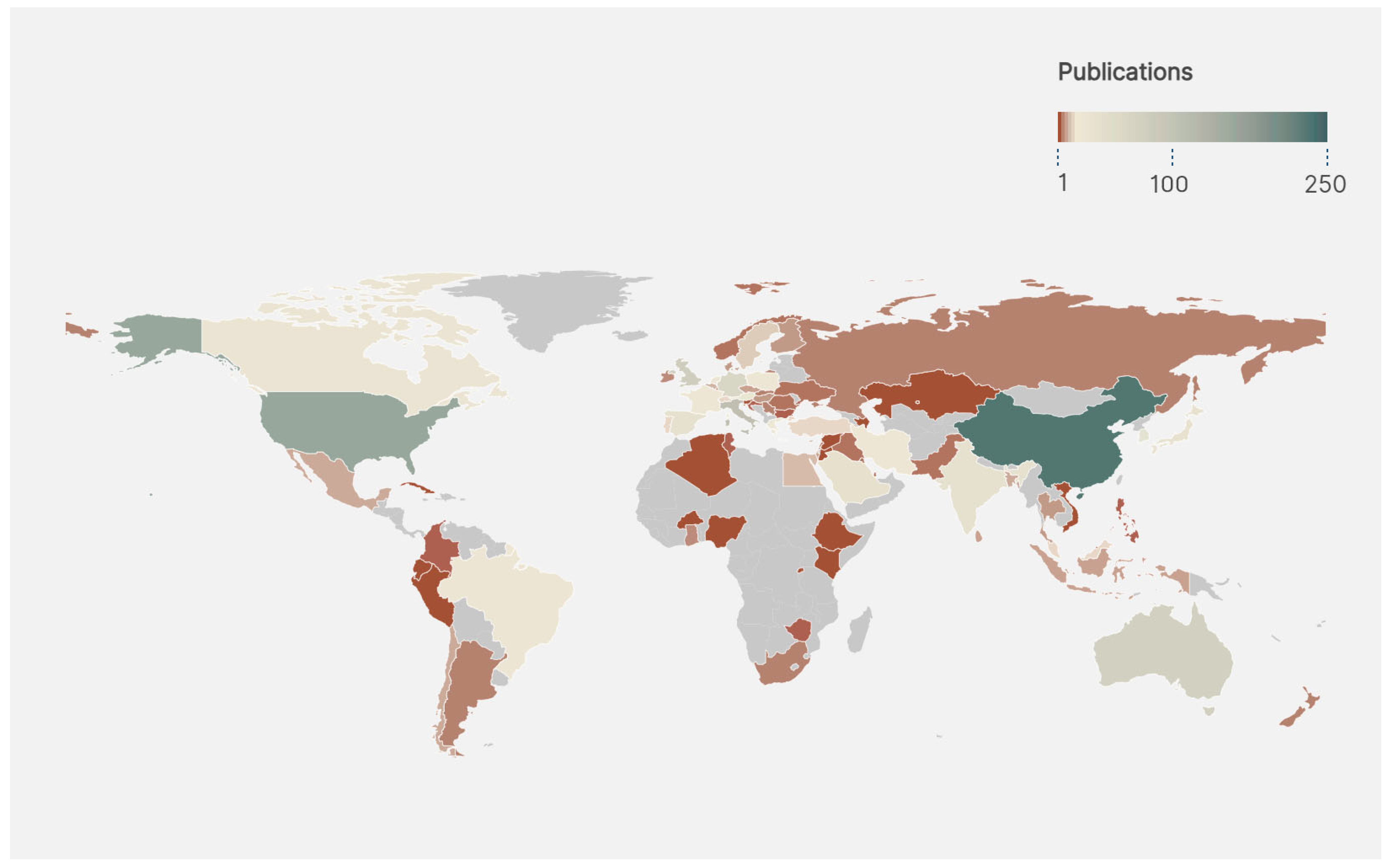

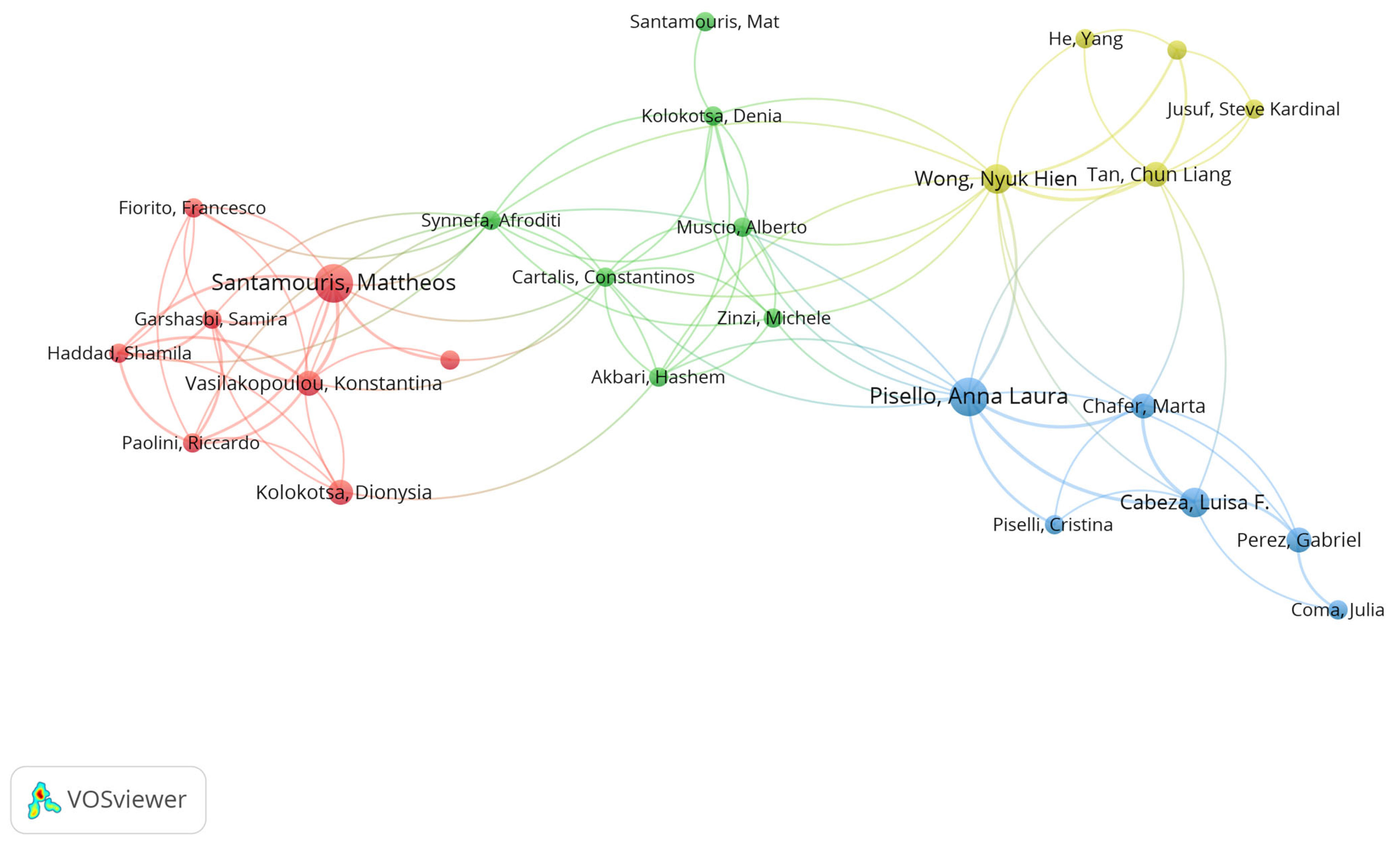
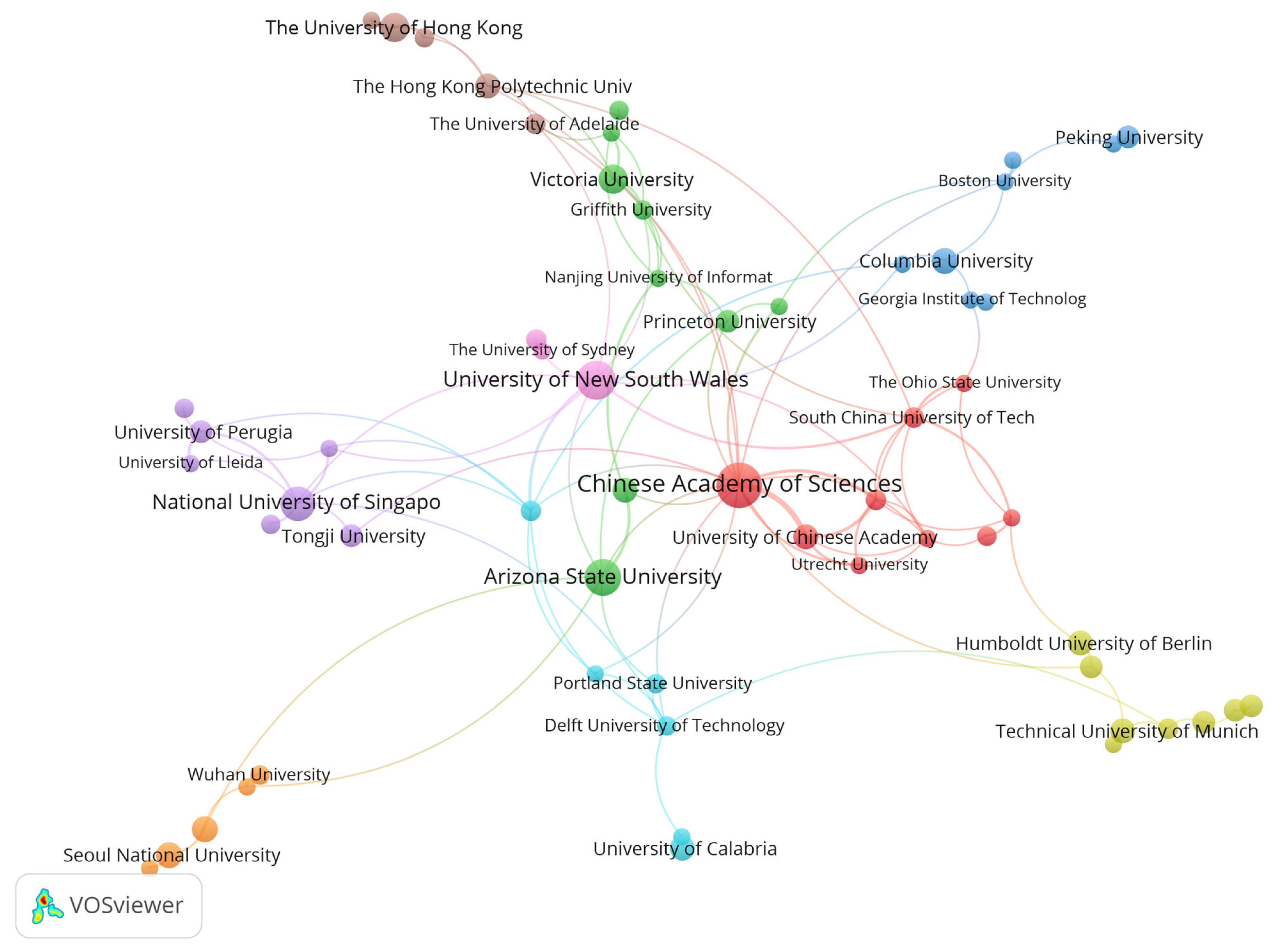

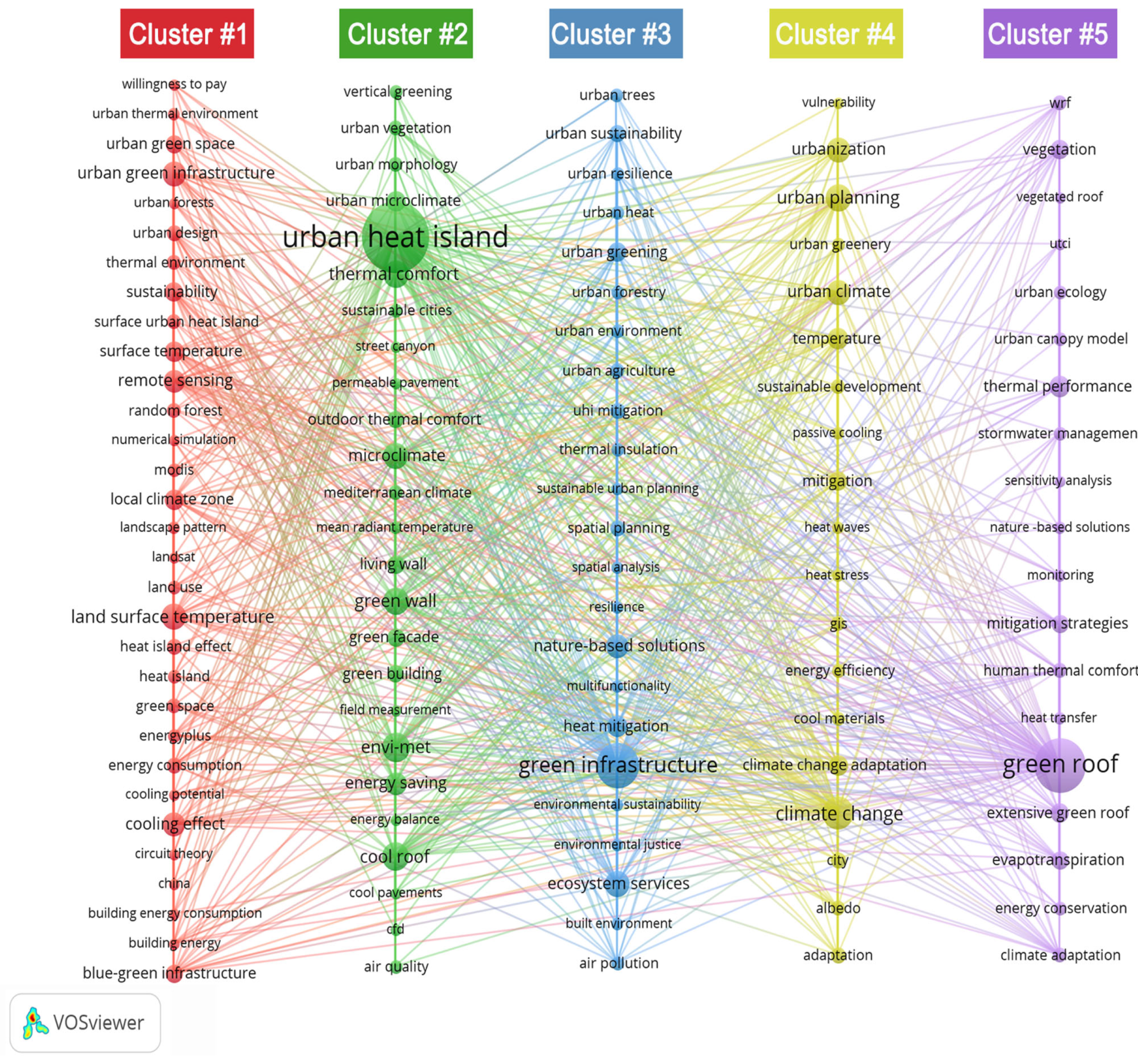
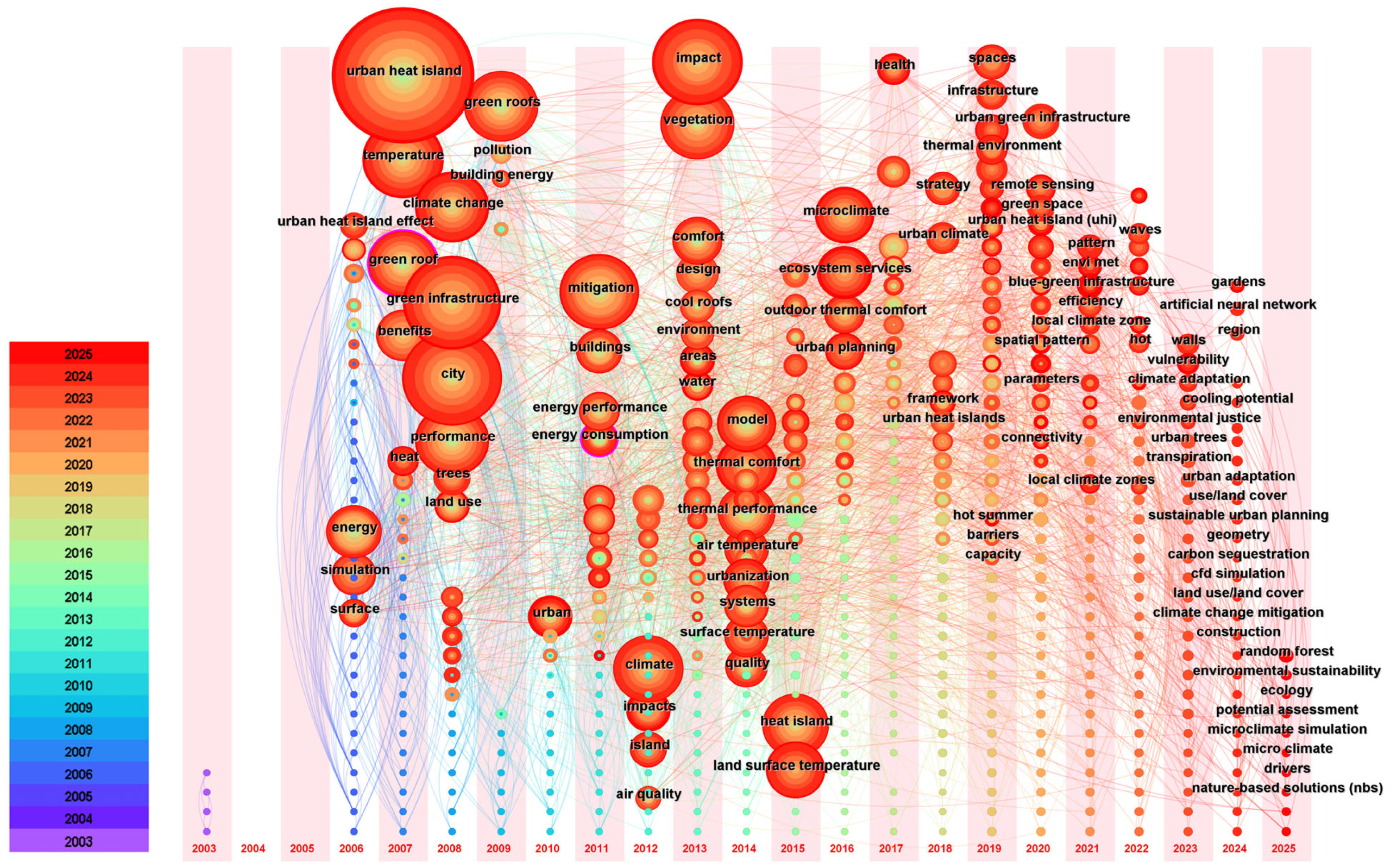

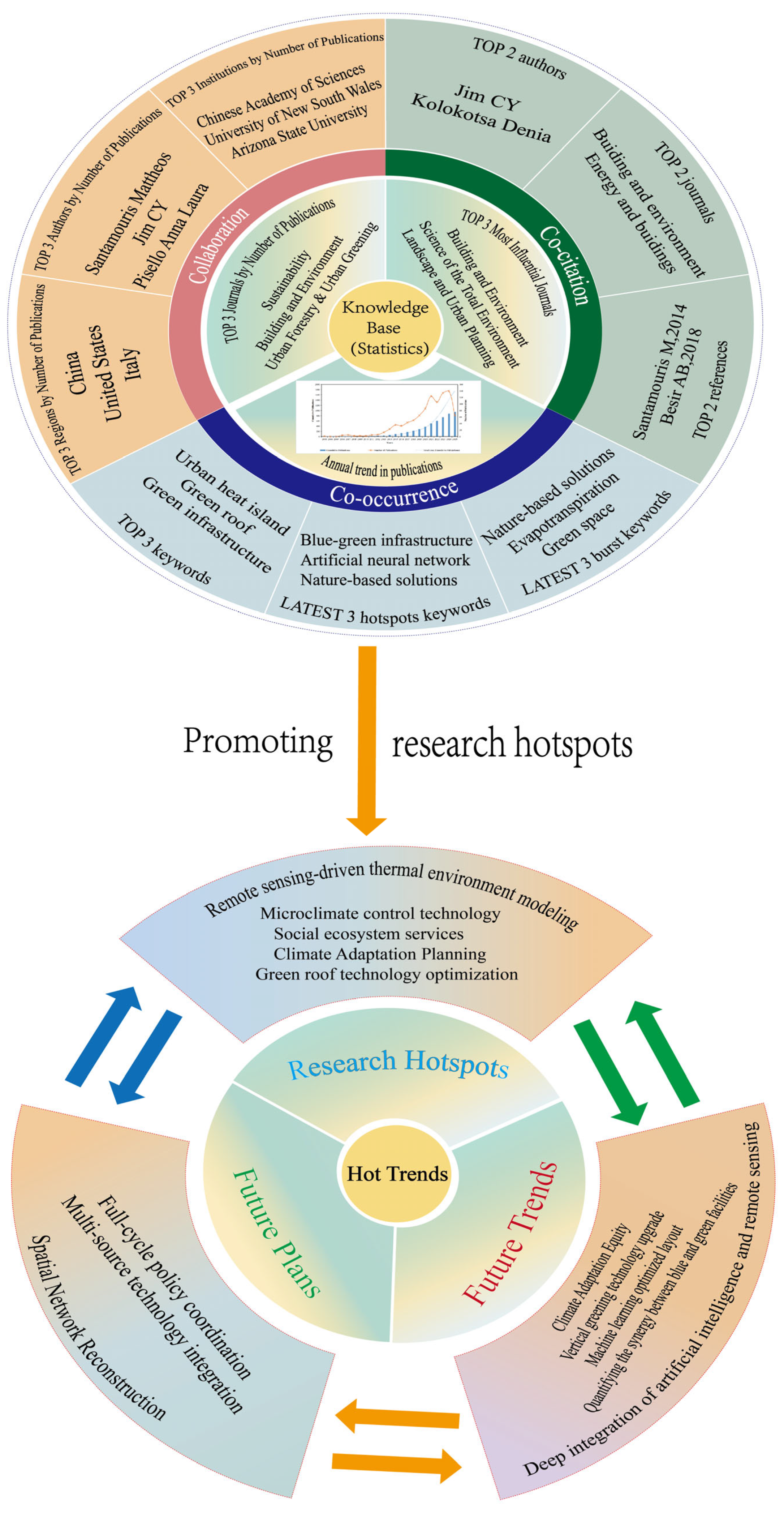
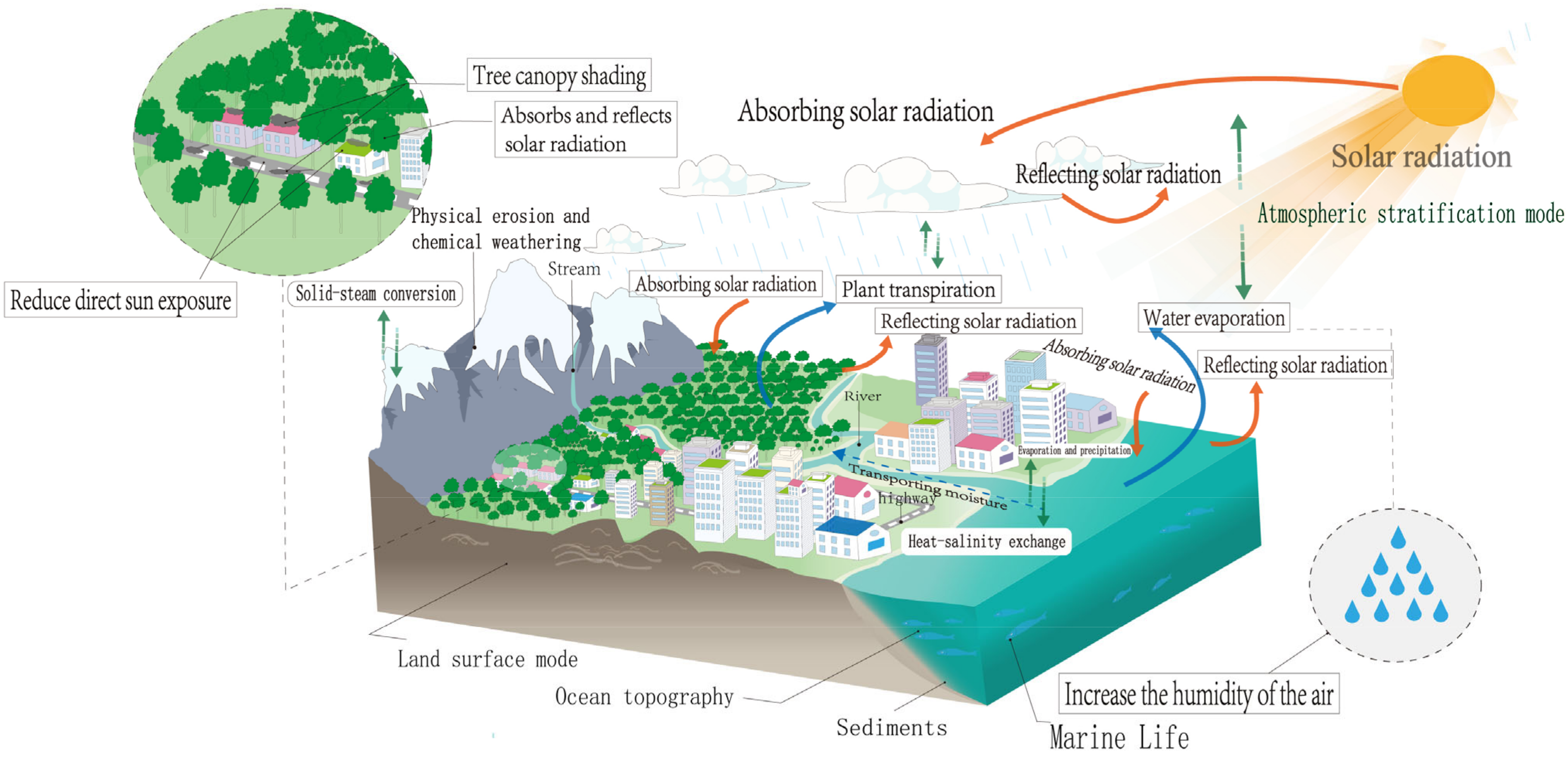
| Rank | Author | NP | NC | AC | TC | H-Index (Wos) |
|---|---|---|---|---|---|---|
| 1 | Santamouris Mattheos | 13 | 1484 | 114.15 | 28,940 | 87 |
| 2 | Jim CY. | 11 | 616 | 56.00 | 13,122 | 60 |
| 3 | Pisello Anna Laura | 8 | 636 | 79.50 | 9121 | 53 |
| 4 | Osmond Paul | 7 | 515 | 73.57 | 1742 | 19 |
| 5 | Kolokotsa Denia | 6 | 1099 | 183.17 | 798 | 13 |
| 6 | Ng Edward | 6 | 352 | 58.67 | 11,437 | 58 |
| 7 | Wong Nyuk Hien | 6 | 760 | 126.67 | 7859 | 46 |
| 8 | Stephan Pauleit | 6 | 495 | 82.5 | 9800 | 52 |
| 9 | Gaffin, Stuart | 6 | 110 | 18.3 | 3179 | 20 |
| 10 | Lee, DongKun | 6 | 91 | 15.1 | 2771 | 30 |
| Rank | Institutions | NP | NC | AC | Total Link Strength |
|---|---|---|---|---|---|
| 1 | Chinese Academy of Sciences | 25 | 1062 | 42.28 | 88 |
| 2 | University of New South Wales | 19 | 1521 | 80.05 | 33 |
| 3 | Arizona State University | 17 | 1031 | 60.65 | 25 |
| 4 | National University of Singapore | 16 | 1371 | 85.69 | 31 |
| 5 | Victoria University | 12 | 414 | 34.50 | 27 |
| 6 | University of Hong Kong | 12 | 686 | 57.17 | 12 |
| 7 | Columbia University | 10 | 1017 | 101.70 | 25 |
| 8 | Seoul National University | 10 | 317 | 31.70 | 23 |
| 9 | Texas A&M University | 10 | 356 | 35.60 | 17 |
| 10 | University of Natural Resources and Life Sciences | 10 | 144 | 14.40 | 12 |
| Rank | Journal | NP | NC | AC | H-Index | IF (JCR 2024) |
|---|---|---|---|---|---|---|
| 1 | Sustainability | 90 | 1352 | 15.02 | 24 | 3.3 |
| 2 | Building and Environment | 74 | 4195 | 56.69 | 24 | 7.1 |
| 3 | Urban Forestry & Urban Greening | 54 | 2402 | 44.48 | 24 | 6.0 |
| 4 | Sustainable Cities and Society | 53 | 1778 | 33.55 | 17 | 11.7 |
| 5 | Energy and Buildings | 52 | 3235 | 62.21 | 16 | 6.6 |
| 6 | Urban Climate | 35 | 842 | 24.06 | 3.2 | 6.0 |
| 7 | Science of the Total Environment | 29 | 1824 | 62.90 | 4.9 | 8.2 |
| 8 | Land | 21 | 171 | 8.14 | 18 | 3.2 |
| 9 | Landscape and Urban Planning | 20 | 2256 | 112.80 | 16 | 7.9 |
| 10 | Buildings | 19 | 154 | 8.11 | 17 | 3.1 |
| Ranking | Keyword | Occurrences | Total Link Strength |
|---|---|---|---|
| 1 | urban heat island | 279 | 2865 |
| 2 | city | 232 | 2392 |
| 3 | urban heat-island | 215 | 2289 |
| 4 | green infrastructure | 209 | 2059 |
| 5 | impact | 206 | 2237 |
| 6 | mitigation | 173 | 1825 |
| 7 | temperature | 173 | 1842 |
| 8 | vegetation | 149 | 1658 |
| 9 | green roofs | 148 | 1534 |
| 10 | performance | 141 | 1449 |
| 11 | climate | 135 | 1471 |
| 12 | green roof | 129 | 1233 |
| 13 | microclimate | 111 | 1249 |
| 14 | heat-island | 100 | 1075 |
| 15 | thermal comfort | 97 | 1023 |
| 16 | model | 93 | 942 |
| 17 | climate-change | 92 | 961 |
| 18 | energy | 89 | 961 |
| 19 | benefits | 83 | 825 |
| 20 | ecosystem services | 82 | 797 |
Disclaimer/Publisher’s Note: The statements, opinions and data contained in all publications are solely those of the individual author(s) and contributor(s) and not of MDPI and/or the editor(s). MDPI and/or the editor(s) disclaim responsibility for any injury to people or property resulting from any ideas, methods, instructions or products referred to in the content. |
© 2025 by the authors. Licensee MDPI, Basel, Switzerland. This article is an open access article distributed under the terms and conditions of the Creative Commons Attribution (CC BY) license (https://creativecommons.org/licenses/by/4.0/).
Share and Cite
Lian, F.; Yi, W.; Ji, G.; Xia, J.; Wang, H. The Impact of Green Infrastructure on Mitigating Urban Heat Island Effect: Current Status, Trends, and Challenges. Forests 2025, 16, 1450. https://doi.org/10.3390/f16091450
Lian F, Yi W, Ji G, Xia J, Wang H. The Impact of Green Infrastructure on Mitigating Urban Heat Island Effect: Current Status, Trends, and Challenges. Forests. 2025; 16(9):1450. https://doi.org/10.3390/f16091450
Chicago/Turabian StyleLian, Fengmei, Wei Yi, Guibin Ji, Jun Xia, and Huiyu Wang. 2025. "The Impact of Green Infrastructure on Mitigating Urban Heat Island Effect: Current Status, Trends, and Challenges" Forests 16, no. 9: 1450. https://doi.org/10.3390/f16091450
APA StyleLian, F., Yi, W., Ji, G., Xia, J., & Wang, H. (2025). The Impact of Green Infrastructure on Mitigating Urban Heat Island Effect: Current Status, Trends, and Challenges. Forests, 16(9), 1450. https://doi.org/10.3390/f16091450









